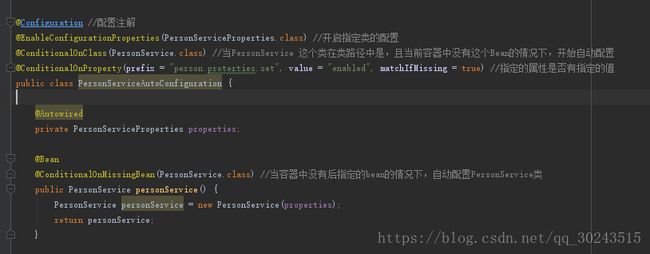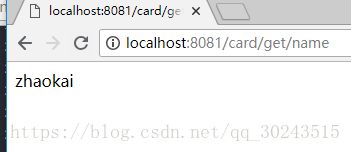- springCloud集成tdengine(原生和mapper方式) 其一
张小娟
springcloudtdenginemybatis
第一种mapper方式,原生方式在主页看第二章一、添加pom文件com.zaxxerHikariCPcom.taosdata.jdbctaos-jdbcdriver3.5.3二、在nacos中配置好数据库连接spring:datasource:url:jdbc:TAOS://localhost:6030/testusername:rootpassword:yourPassWorddriver-cl
- springCloud集成tdengine(原生和mapper方式) 其二 原生篇
张小娟
springcloudtdenginespring
mapper篇请看另一篇文章一、引入pom文件com.taosdata.jdbctaos-jdbcdriver3.5.3二、在nacos中填写数据库各种value值tdengine:datasource:location:yourLocationusername:rootpassword:yourPassword三、编写TDengineUtil文件下方util文件里面,包含创建database的方
- 什么是Spring Boot?它在Java后端开发中的作用是什么?
破碎的天堂鸟
学习教程javaspringboot数据库
什么是SpringBoot?SpringBoot是由Pivotal团队开发的一个基于Spring框架的快速开发框架,旨在简化Spring应用的初始搭建和开发流程。其核心理念是“约定优于配置”(ConventionoverConfiguration),通过默认配置和自动化机制,使开发者能够快速构建独立的、生产级别的应用程序。以下是其核心定义与特点:基于Spring的扩展与优化SpringBoot并非
- 庖丁解java(一篇文章学java)
庖丁解java
java开发语言springboot后端
(大家不用收藏这篇文章,因为这篇文章会经常更新,也就是删除后重发)一篇文章学java,这是我滴一个执念...当然,真一篇文章就写完java基础,java架构,java业务实现,java业务扩展,根本不可能.所以,这篇文章,就是一个索引,索什么呢?请看下文...关于决定开始写博文的介绍(一切故事的起点源于这一次反省)中小技术公司的软扩展(微服务扩展是否有必要?)-CSDN博客SpringCloud(
- 深入探讨Spring MVC:原理、架构与实践
luckilyil
开发框架springmvc架构
SpringMVC原理与架构解析1.SpringMVC概述SpringMVC是Spring框架中的一个模块,专注于实现Web应用的MVC设计模式。它通过将应用逻辑分为模型(Model)、视图(View)和控制器(Controller),使得开发人员能够清晰地组织代码,提高开发效率和可维护性。2.SpringMVC的核心组件SpringMVC的核心组件包括:DispatcherServlet:作为前
- 同时使用接口文档swagger和knife4j
黑taoA
java开发语言
项目场景:springboot项目中同时使用接口文档swagger和knife4j问题描述在实体类中设置了字段必填的属性,在访问接口文档时出现异常实体类关键代码片段/***部门表sys_dept*/publicclassSysDeptextendsBaseEntity{privatestaticfinallongserialVersionUID=1L;/**部门ID*/privateLongdep
- SpringCloud框架下的注册中心比较:Eureka与Consul的实战解析
耶耶Norsea
网络杂烩springcloud
摘要在探讨SpringCloud框架中的两种注册中心之前,有必要回顾单体架构与分布式架构的特点。单体架构将所有业务功能集成在一个项目中,优点是架构简单、部署成本低,但耦合度高。分布式架构则根据业务功能对系统进行拆分,每个模块作为独立服务开发,降低了服务间的耦合,便于升级和扩展,然而其复杂性增加,运维、监控和部署难度也随之提高。关键词SpringCloud,注册中心,单体架构,分布式架构,服务拆分一
- 程序员晋升架构师实战指南
甘苦人生
职业规划职场和发展
以下是为程序员量身定制的晋升架构师实战指南,结合行业案例与可落地路径,助你完成技术跃迁:一、晋升路径拆解(从Code到Architecture)程序员→高级工程师核心任务:独立完成模块开发(需求分析+方案设计+编码实现)技术重点:掌握1-2门核心语言(如Java/Go)、熟悉主流框架(SpringCloud/Dubbo)案例:主导用户中心模块开发,通过缓存优化将接口响应时间从800ms降至150m
- Spring Cloud Config 快速介绍与实例
oscar999
SpringBoot实战开发大全SpringBootCloudConfig
SpringCloudConfig是什么?SpringCloudConfig是一个用于分布式系统的配置管理工具,提供集中化的外部配置支持。它适用于微服务架构,能够将各个服务的配置集中存储在服务端(如Git仓库),客户端按需动态获取配置,解决了配置分散、环境切换复杂等问题。SpringCloudConfig核心概念ConfigServer:配置中心服务端,统一管理配置,支持Git、本地文件等存储方式
- Spring Boot拦截器(Interceptor)与过滤器(Filter)深度解析:区别、实现与实战指南
QQ828929QQ
springboot后端java
SpringBoot拦截器(Interceptor)与过滤器(Filter)深度解析:区别、实现与实战指南一、核心概念对比1.本质区别维度过滤器(Filter)拦截器(Interceptor)规范层级Servlet规范(J2EE标准)SpringMVC框架机制作用范围所有请求(包括静态资源)只处理Controller请求依赖关系不依赖Spring容器完全集成SpringIOC容器执行顺序最先执行(
- Spring Boot 整合 RabbitMQ:注解声明队列与交换机详解
Cloud_.
java-rabbitmqspringbootrabbitmqMQ消息队列
RabbitMQ作为一款高性能的消息中间件,在分布式系统中广泛应用。SpringBoot通过spring-boot-starter-amqp提供了对RabbitMQ的无缝集成,开发者可以借助注解快速声明队列、交换机及绑定规则,极大简化了配置流程。本文将通过代码示例和原理分析,详细介绍如何用注解实现RabbitMQ的集成,并深入解析交换机的作用与类型。一、环境准备1.添加依赖在pom.xml中引入S
- 191113面试题总结
快乐男孩小东
1.Maven中A依赖BB依赖C那么A可以使用C中的类吗?*按照依赖关系,可推C继承A,则C可以使用A中修饰符为public,protected的类2.SpringBoot中有一个类标记了@Controller注解,通过自动扫描把这个类的对象加入IOC,那么这个类应该放那?*在@SpringBootApplication所在包或者下面的子包,才能被自动扫描到#3.通过Maven下载jar包,下载失
- SpringbootActuator未授权访问漏洞
web_15534274656
面试学习路线阿里巴巴java
漏洞介绍Actuator是SpringBoot提供的用来对应用系统进行自省和监控的功能模块,借助于Actuator开发者可以很方便地对应用系统某些监控指标进行查看、统计等。然而,其默认配置会出现接口未授权访问,导致部分接口会泄露网站数据库连接信息等配置信息,使用Jolokia库特性甚至可以远程执行任意代码,获取服务器权限。1、漏洞危害1、信息泄露:未授权的访问者可以通过Actuator端点获取敏感
- SpringBoot + Facade Pattern : 通过统一接口简化多模块业务
Java布道者
springboot外观模式后端
概述外观设计模式(FacadePattern)是一种常见的结构型设计模式,它的主要目的是简化复杂系统的使用。可以把它想象成一个“控制面板”或者“遥控器”,通过这个控制面板,用户可以轻松操作一个复杂的系统,而不需要关心系统内部是如何运作的。举个生活中的例子,想象一下,你家有一台多功能的家电,比如一台智能电视,它不仅能看电视,还能上网、播放视频、控制智能家居等等。对于电视的操作,你有遥控器,可以通过一
- SpringMVC-解决跨域的两种方案
青岛欢迎您
开发框架springmvc
1.什么是跨域跨域,即跨站HTTP请求(Cross-siteHTTPrequest),指发起请求的资源所在域不同于请求指向资源所在域的HTTP请求。2.跨域的应用情景当使用前后端分离,后端主导的开发方式进行前后端协作开发时,常常有如下情景:后端开发完毕在服务器上进行部署并给前端API文档。前端在本地进行开发并向远程服务器上部署的后端发送请求。在这种开发过程中,如果前端想要一边开发一边测试接口,就需
- RestTemplate和RPC区别
酷爱码
经验分享rpc网络协议网络
RestTemplate是Spring框架中用于进行RESTful风格的HTTP请求的模板类,通常用于与外部服务进行通信。它基于HTTP协议,使用GET、POST、PUT、DELETE等HTTP方法来进行通信,传输的数据通常使用JSON或XML格式。它是一种基于资源的通信方式,通过URL来标识资源。RPC(RemoteProcedureCall)是一种远程过程调用的通信机制,用于不同进程或不同主机
- Jarslink 是一个 SOFA 方舟插件,用于管理多应用部署
后端java
前言大家好,我是老马。sofastack其实出来很久了,第一次应该是在2022年左右开始关注,但是一直没有深入研究。最近想学习一下SOFA对于生态的设计和思考。sofaboot系列SOFABoot-00-sofaboot概览SOFABoot-01-蚂蚁金服开源的sofaboot是什么黑科技?SOFABoot-02-模块化隔离方案SOFABoot-03-sofaboot介绍SOFABoot-04-快
- 若依集成knife4j实现swagger文档增强
Roc-xb
knife4j
knife4j的前身是swagger-bootstrap-ui,为了契合微服务的架构发展,由于原来swagger-bootstrap-ui采用的是后端Java代码+前端Ui混合打包的方式,在微服务架构下显的很臃肿,因此项目正式更名为knife4j。目录一、单体版本1、ruoyi-admin\pom.xml模块添加整合依赖2、SwaggerController.java修改跳转访问地址二、前后端分离
- knife4j,微服务聚合Swagger文档
图书馆的小盆友
java开发相关微服务javamicroservices
前置知识我们将采用Nacos作为注册中心,Gateway作为网关,使用knife4j来生成API文档,对这些技术不了解的朋友可以看下下面的文章。SpringCloudGateway:新一代API网关服务SpringCloudAlibaba:Nacos作为注册中心和配置中心使用给Swagger换了个新皮肤,瞬间高大上了!应用架构我们理想的解决方案应该是这样的,网关作为API文档的统一入口,网关聚合所
- 基于JAVA中的spring框架和jsp实现自然灾害论坛平台项目【附项目源码+论文说明】
大雄是个程序员
项目实践自然灾害论坛平台java项目源码spring毕业设计课程设计网页设计
摘要在上个世纪末期,也就是20世纪末,随着计算机技术的发展与进步和数据库方面的知识在互联网的大力运用,互联网技术以及网站技术在网上的大力推广,网上论坛(自然灾害论坛)也逐渐在网兴起,它的出现帮助了网上各种特定的群体进行一个在线的知识传递与信息的交流。本计算机自然灾害论坛设计,采用了JSP(JAVA)技术和MYSQL数据库开发,尝试实现了自然灾害论坛的基本功能以及帮助我们掌握了论坛技术的核心特点。该
- Java架构师成长之路
hweiyu00
分享spring微服务springcloudjava
概述本教程主要从6个方面,全面讲解Java技术栈的知识。1.性能调优深入理解MySQL底层原理、索引逻辑,数据结构与算法。使用Explain进行优化分析MVCC原理剖析日志机制解析2.框架源码掌握Spring底层原理带你手写一个Spring解析IOC、AOP源码、以及事务原理3.并发编程剖析Java底层锁机制CAS、JUC工具使用、AQS源码分析以及并发的集合类的讲解4.分布式开发剖析分布式中使用
- 穴位按摩培训系统Django-SpringBoot-php-Node.js-flask
QQ188083800
djangospringbootphp
目录具体实现截图技术栈介绍系统设计研究方法:设计步骤设计流程核心代码部分展示研究方法详细视频演示试验方案论文大纲源码获取/详细视频演示具体实现截图技术栈介绍本课题的研究方法和研究步骤基本合理,难度适中,本选题是学生所学专业知识的延续,符合学生专业发展方向,对于提高学生的基本知识和技能以及钻研能力有益。该学生能够在预定时间内完成该课题的设计。研究的选题立意明确,结构合理,研究内容充实,研究方法准确有
- RocketMQ学习-Springboot整合RocketMQ
wechatt_fee1024
面试mavenspringbootjava
SpringBoot整合RocketMQ需要注意的是SpringBoot的starter集成包时,要注意版本。因为SpringBoot集成的RocketMQ的starter依赖由Spring社区提供,迭代比较快,版本之间的差异还是比较大的。可能版本不同,就导致使用的时候出现错误。maven依赖,直接把我的maven工程的配置放到这里了。普通消息maven工程创建我直接创建了一个空的maven工程,
- 【商城实战(55)】商城数据库备份:策略与实操指南
奔跑吧邓邓子
商城实战商城实战数据库备份MySQL策略与实操
【商城实战】专栏重磅来袭!这是一份专为开发者与电商从业者打造的超详细指南。从项目基础搭建,运用uniapp、ElementPlus、SpringBoot搭建商城框架,到用户、商品、订单等核心模块开发,再到性能优化、安全加固、多端适配,乃至运营推广策略,102章内容层层递进。无论是想深入钻研技术细节,还是探寻商城运营之道,本专栏都能提供从0到1的系统讲解,助力你打造独具竞争力的电商平台,开启电商实战
- fastjosn注册自定义序列化器
林发和
开发语言java
自定义序列化器: importcom.alibaba.fastjson.serializer.JSONSerializer; importcom.alibaba.fastjson.serializer.ObjectSerializer; importorg.springframework.boot.actuate.health.Status; importjava.io.IOExcepti
- SpringBoot 整合security 实现自定义Token和clientId登录及退出(二)
.猫的树
springbootspringjava
接上一篇6.认证相关处理创建登录成功DemoAuthenticationSuccessHandler.java/***用户身份验证通过处理*/@Component@SuppressWarnings("all")publicclassDemoAuthenticationSuccessHandlerimplementsAuthenticationSuccessHandler{@Autowiredpri
- rocketmq-client 4.3.0 在springboot中的使用
Myueye
JAVAjava
rocketmq-client4.3.0在springboot中的使用1、导入依赖2、配置文件属性3、编写配置类4、使用测试5、结果5.1RocketMQ后台显示5.2前端页面5.3后端后台1、导入依赖org.apache.rocketmqrocketmq-client4.3.02、配置文件属性mq.nameserverAdd=ip地址:9876mq.topic=top1(topic名称)mq.p
- Spring Bean 的生命周期:从创建到销毁的完整解析
一点多余.
java开发语言
引言:为什么需要了解SpringBean的生命周期?在Spring框架中,Bean是应用程序的核心构建块,理解其生命周期对于开发高效、稳定的应用至关重要。根据2023年JetBrains开发者调查报告,超过75%的Java开发者使用Spring框架,而Bean的生命周期管理是Spring的核心特性之一。以下数据展示了Bean生命周期的重要性:90%的Spring性能问题与Bean的初始化或销毁不当
- SpringAOP-基本概念-AOP入门程序-核心概念-通知类型-通知顺序-切入点表达式-连接点joinpoint-记录操作日志-获取当前登录员工
汐栊
java开发语言springmvc数据库
目录SpringAOP:AOP快速入门:AOP核心概念:AOP进阶:通知类型:注意事项:方法实现:@PointCutAOP通知顺序:执行顺序:不同切面类中,默认按照切面类的类名字母排序。用@Order(数字)加在切面类上来控制顺序AOP切入点表达式:切入点表达式-execution:切入点表达式-@annotation:可以使用通配符描述切入点:AOP连接点:AOP案例:将案例中增,删,改相关接口
- Spring事务失效的常见场景
红云梦
springjava数据库
1事务1.1数据库事务作为单个逻辑工作单元执行的一系列操作,要么完全执行,要么完全不执行1.2事务的四大特性(ACID)原子性(Atomicity):要么成功,要么失败。一个事务内的所有SQL语句同步执行(依靠undo.log日志保证)一致性(Consistency):事务前后总量不变,数据库完整性约束没有被破坏隔离性(Isolation):一个事务执行不被其他事务干扰(锁+MVCC)持久性(Du
- redis学习笔记——不仅仅是存取数据
Everyday都不同
returnSourceexpire/delincr/lpush数据库分区redis
最近项目中用到比较多redis,感觉之前对它一直局限于get/set数据的层面。其实作为一个强大的NoSql数据库产品,如果好好利用它,会带来很多意想不到的效果。(因为我搞java,所以就从jedis的角度来补充一点东西吧。PS:不一定全,只是个人理解,不喜勿喷)
1、关于JedisPool.returnSource(Jedis jeids)
这个方法是从red
- SQL性能优化-持续更新中。。。。。。
atongyeye
oraclesql
1 通过ROWID访问表--索引
你可以采用基于ROWID的访问方式情况,提高访问表的效率, , ROWID包含了表中记录的物理位置信息..ORACLE采用索引(INDEX)实现了数据和存放数据的物理位置(ROWID)之间的联系. 通常索引提供了快速访问ROWID的方法,因此那些基于索引列的查询就可以得到性能上的提高.
2 共享SQL语句--相同的sql放入缓存
3 选择最有效率的表
- [JAVA语言]JAVA虚拟机对底层硬件的操控还不完善
comsci
JAVA虚拟机
如果我们用汇编语言编写一个直接读写CPU寄存器的代码段,然后利用这个代码段去控制被操作系统屏蔽的硬件资源,这对于JVM虚拟机显然是不合法的,对操作系统来讲,这样也是不合法的,但是如果是一个工程项目的确需要这样做,合同已经签了,我们又不能够这样做,怎么办呢? 那么一个精通汇编语言的那种X客,是否在这个时候就会发生某种至关重要的作用呢?
&n
- lvs- real
男人50
LVS
#!/bin/bash
#
# Script to start LVS DR real server.
# description: LVS DR real server
#
#. /etc/rc.d/init.d/functions
VIP=10.10.6.252
host='/bin/hostname'
case "$1" in
sta
- 生成公钥和私钥
oloz
DSA安全加密
package com.msserver.core.util;
import java.security.KeyPair;
import java.security.PrivateKey;
import java.security.PublicKey;
import java.security.SecureRandom;
public class SecurityUtil {
- UIView 中加入的cocos2d,背景透明
374016526
cocos2dglClearColor
要点是首先pixelFormat:kEAGLColorFormatRGBA8,必须有alpha层才能透明。然后view设置为透明glView.opaque = NO;[director setOpenGLView:glView];[self.viewController.view setBackgroundColor:[UIColor clearColor]];[self.viewControll
- mysql常用命令
香水浓
mysql
连接数据库
mysql -u troy -ptroy
备份表
mysqldump -u troy -ptroy mm_database mm_user_tbl > user.sql
恢复表(与恢复数据库命令相同)
mysql -u troy -ptroy mm_database < user.sql
备份数据库
mysqldump -u troy -ptroy
- 我的架构经验系列文章 - 后端架构 - 系统层面
agevs
JavaScriptjquerycsshtml5
系统层面:
高可用性
所谓高可用性也就是通过避免单独故障加上快速故障转移实现一旦某台物理服务器出现故障能实现故障快速恢复。一般来说,可以采用两种方式,如果可以做业务可以做负载均衡则通过负载均衡实现集群,然后针对每一台服务器进行监控,一旦发生故障则从集群中移除;如果业务只能有单点入口那么可以通过实现Standby机加上虚拟IP机制,实现Active机在出现故障之后虚拟IP转移到Standby的快速
- 利用ant进行远程tomcat部署
aijuans
tomcat
在javaEE项目中,需要将工程部署到远程服务器上,如果部署的频率比较高,手动部署的方式就比较麻烦,可以利用Ant工具实现快捷的部署。这篇博文详细介绍了ant配置的步骤(http://www.cnblogs.com/GloriousOnion/archive/2012/12/18/2822817.html),但是在tomcat7以上不适用,需要修改配置,具体如下:
1.配置tomcat的用户角色
- 获取复利总收入
baalwolf
获取
public static void main(String args[]){
int money=200;
int year=1;
double rate=0.1;
&
- eclipse.ini解释
BigBird2012
eclipse
大多数java开发者使用的都是eclipse,今天感兴趣去eclipse官网搜了一下eclipse.ini的配置,供大家参考,我会把关键的部分给大家用中文解释一下。还是推荐有问题不会直接搜谷歌,看官方文档,这样我们会知道问题的真面目是什么,对问题也有一个全面清晰的认识。
Overview
1、Eclipse.ini的作用
Eclipse startup is controlled by th
- AngularJS实现分页功能
bijian1013
JavaScriptAngularJS分页
对于大多数web应用来说显示项目列表是一种很常见的任务。通常情况下,我们的数据会比较多,无法很好地显示在单个页面中。在这种情况下,我们需要把数据以页的方式来展示,同时带有转到上一页和下一页的功能。既然在整个应用中这是一种很常见的需求,那么把这一功能抽象成一个通用的、可复用的分页(Paginator)服务是很有意义的。
&nbs
- [Maven学习笔记三]Maven archetype
bit1129
ArcheType
archetype的英文意思是原型,Maven archetype表示创建Maven模块的模版,比如创建web项目,创建Spring项目等等.
mvn archetype提供了一种命令行交互式创建Maven项目或者模块的方式,
mvn archetype
1.在LearnMaven-ch03目录下,执行命令mvn archetype:gener
- 【Java命令三】jps
bit1129
Java命令
jps很简单,用于显示当前运行的Java进程,也可以连接到远程服务器去查看
[hadoop@hadoop bin]$ jps -help
usage: jps [-help]
jps [-q] [-mlvV] [<hostid>]
Definitions:
<hostid>: <hostname>[:
- ZABBIX2.2 2.4 等各版本之间的兼容性
ronin47
zabbix更新很快,从2009年到现在已经更新多个版本,为了使用更多zabbix的新特性,随之而来的便是升级版本,zabbix版本兼容性是必须优先考虑的一点 客户端AGENT兼容
zabbix1.x到zabbix2.x的所有agent都兼容zabbix server2.4:如果你升级zabbix server,客户端是可以不做任何改变,除非你想使用agent的一些新特性。 Zabbix代理(p
- unity 3d还是cocos2dx哪个适合游戏?
brotherlamp
unity自学unity教程unity视频unity资料unity
unity 3d还是cocos2dx哪个适合游戏?
问:unity 3d还是cocos2dx哪个适合游戏?
答:首先目前来看unity视频教程因为是3d引擎,目前对2d支持并不完善,unity 3d 目前做2d普遍两种思路,一种是正交相机,3d画面2d视角,另一种是通过一些插件,动态创建mesh来绘制图形单元目前用的较多的是2d toolkit,ex2d,smooth moves,sm2,
- 百度笔试题:一个已经排序好的很大的数组,现在给它划分成m段,每段长度不定,段长最长为k,然后段内打乱顺序,请设计一个算法对其进行重新排序
bylijinnan
java算法面试百度招聘
import java.util.Arrays;
/**
* 最早是在陈利人老师的微博看到这道题:
* #面试题#An array with n elements which is K most sorted,就是每个element的初始位置和它最终的排序后的位置的距离不超过常数K
* 设计一个排序算法。It should be faster than O(n*lgn)。
- 获取checkbox复选框的值
chiangfai
checkbox
<title>CheckBox</title>
<script type = "text/javascript">
doGetVal: function doGetVal()
{
//var fruitName = document.getElementById("apple").value;//根据
- MySQLdb用户指南
chenchao051
mysqldb
原网页被墙,放这里备用。 MySQLdb User's Guide
Contents
Introduction
Installation
_mysql
MySQL C API translation
MySQL C API function mapping
Some _mysql examples
MySQLdb
- HIVE 窗口及分析函数
daizj
hive窗口函数分析函数
窗口函数应用场景:
(1)用于分区排序
(2)动态Group By
(3)Top N
(4)累计计算
(5)层次查询
一、分析函数
用于等级、百分点、n分片等。
函数 说明
RANK() &nbs
- PHP ZipArchive 实现压缩解压Zip文件
dcj3sjt126com
PHPzip
PHP ZipArchive 是PHP自带的扩展类,可以轻松实现ZIP文件的压缩和解压,使用前首先要确保PHP ZIP 扩展已经开启,具体开启方法就不说了,不同的平台开启PHP扩增的方法网上都有,如有疑问欢迎交流。这里整理一下常用的示例供参考。
一、解压缩zip文件 01 02 03 04 05 06 07 08 09 10 11
- 精彩英语贺词
dcj3sjt126com
英语
I'm always here
我会一直在这里支持你
&nb
- 基于Java注解的Spring的IoC功能
e200702084
javaspringbeanIOCOffice
- java模拟post请求
geeksun
java
一般API接收客户端(比如网页、APP或其他应用服务)的请求,但在测试时需要模拟来自外界的请求,经探索,使用HttpComponentshttpClient可模拟Post提交请求。 此处用HttpComponents的httpclient来完成使命。
import org.apache.http.HttpEntity ;
import org.apache.http.HttpRespon
- Swift语法之 ---- ?和!区别
hongtoushizi
?swift!
转载自: http://blog.sina.com.cn/s/blog_71715bf80102ux3v.html
Swift语言使用var定义变量,但和别的语言不同,Swift里不会自动给变量赋初始值,也就是说变量不会有默认值,所以要求使用变量之前必须要对其初始化。如果在使用变量之前不进行初始化就会报错:
var stringValue : String
//
- centos7安装jdk1.7
jisonami
jdkcentos
安装JDK1.7
步骤1、解压tar包在当前目录
[root@localhost usr]#tar -xzvf jdk-7u75-linux-x64.tar.gz
步骤2:配置环境变量
在etc/profile文件下添加
export JAVA_HOME=/usr/java/jdk1.7.0_75
export CLASSPATH=/usr/java/jdk1.7.0_75/lib
- 数据源架构模式之数据映射器
home198979
PHP架构数据映射器datamapper
前面分别介绍了数据源架构模式之表数据入口、数据源架构模式之行和数据入口数据源架构模式之活动记录,相较于这三种数据源架构模式,数据映射器显得更加“高大上”。
一、概念
数据映射器(Data Mapper):在保持对象和数据库(以及映射器本身)彼此独立的情况下,在二者之间移动数据的一个映射器层。概念永远都是抽象的,简单的说,数据映射器就是一个负责将数据映射到对象的类数据。
&nb
- 在Python中使用MYSQL
pda158
mysqlpython
缘由 近期在折腾一个小东西须要抓取网上的页面。然后进行解析。将结果放到
数据库中。 了解到
Python在这方面有优势,便选用之。 由于我有台
server上面安装有
mysql,自然使用之。在进行数据库的这个操作过程中遇到了不少问题,这里
记录一下,大家共勉。
python中mysql的调用
百度之后能够通过MySQLdb进行数据库操作。
- 单例模式
hxl1988_0311
java单例设计模式单件
package com.sosop.designpattern.singleton;
/*
* 单件模式:保证一个类必须只有一个实例,并提供全局的访问点
*
* 所以单例模式必须有私有的构造器,没有私有构造器根本不用谈单件
*
* 必须考虑到并发情况下创建了多个实例对象
* */
/**
* 虽然有锁,但是只在第一次创建对象的时候加锁,并发时不会存在效率
- 27种迹象显示你应该辞掉程序员的工作
vipshichg
工作
1、你仍然在等待老板在2010年答应的要提拔你的暗示。 2、你的上级近10年没有开发过任何代码。 3、老板假装懂你说的这些技术,但实际上他完全不知道你在说什么。 4、你干完的项目6个月后才部署到现场服务器上。 5、时不时的,老板在检查你刚刚完成的工作时,要求按新想法重新开发。 6、而最终这个软件只有12个用户。 7、时间全浪费在办公室政治中,而不是用在开发好的软件上。 8、部署前5分钟才开始测试。









